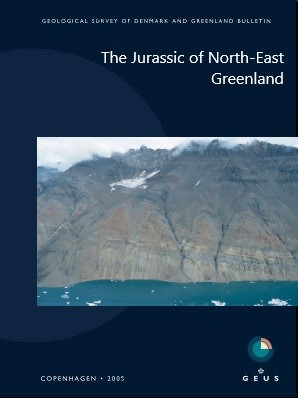A new Middle–Upper Jurassic succession on Hold with Hope, North-East Greenland
DOI:
https://doi.org/10.34194/geusb.v5.4807Keywords:
Hall Bredning Group, Hold with Hope, lithostratigraphy, North-East Greenland, palaeogeography, sedimentology, shallow marine, Spath Plateau Member, Vardekløft GroupAbstract
A succession of marine, Jurassic sediments was recently discovered on Hold with Hope, North-East Greenland. The discovery shows that the area was covered by the sea during Middle–Late Jurassic transgressive events and thus adds to the understanding of the palaeogeography of the area. The Jurassic succession on northern Hold with Hope is exposed in the hangingwalls of small fault blocks formed by rifting in Late Jurassic – Early Cretaceous times. It unconformably overlies Lower Triassic siltstones and sandstones and is overlain by Lower Cretaceous coarse-grained sandstones with an angular unconformity. The succession is up to 360 m thick and includes sandstones of the Lower–Upper Callovian Pelion and Middle–Upper Oxfordian Payer Dal Formations (Vardekløft Group) and heteroliths and mudstones of the Upper Oxfordian – Lower Kimmeridgian Bernbjerg Formation (Hall Bredning Group). The Pelion Formation includes the new Spath Plateau Member (defined herein). The palaeogeographic setting was a narrow rift-controlled embayment along the western margin of the rifted Jurassic seaway between Greenland and Norway. It was open to marine circulation to the south as indicated by the distribution and lateral facies variations and a dominant south-westwards marine palaeocurrent direction. The Pelion and Payer Dal Formations represent upper shoreface and tidally influenced delta deposits formed by the migration of dunes in distributary channels and mouthbars over the delta front. The boundary between the two formations is unconformable and represents a Late Callovian – Middle Oxfordian hiatus. It is interpreted to have formed by subaerial erosion related to a sea-level fall combined with minor tilting of fault blocks and erosion of uplifted block crests. In Late Jurassic time, the sand-rich depositional systems of the Pelion and Payer Dal Formations drowned and offshore transition – lower shoreface heteroliths and offshore mudstones of the Bernbjerg Formation accumulated. The fault block crest forming the eastern basin margin was inundated by a rise in relative sea level. Major fault activity probably occurred in latest Jurassic – Early Cretaceous times when the major fault block originally defining the Hold with Hope basin was split into smaller blocks.
Downloads
Downloads
Published
How to Cite
Issue
Section
License
GEUS Bulletin is an open-access, peer-reviewed journal published by the Geological Survey of Denmark and Greenland (GEUS). This article is distributed under a CC-BY 4.0 licence, permitting free redistribution and reproduction for any purpose, even commercial, provided proper citation of the original work. Author(s) retain copyright over the article contents. Read the full open access policy.







